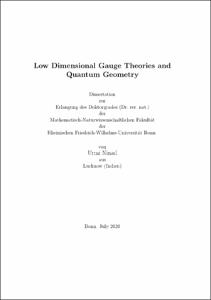Ninad, Urmi: Low Dimensional Gauge Theories and Quantum Geometry. - Bonn, 2020. - Dissertation, Rheinische Friedrich-Wilhelms-Universität Bonn.
Online-Ausgabe in bonndoc: https://nbn-resolving.org/urn:nbn:de:hbz:5-59844
Online-Ausgabe in bonndoc: https://nbn-resolving.org/urn:nbn:de:hbz:5-59844
@phdthesis{handle:20.500.11811/8672,
urn: https://nbn-resolving.org/urn:nbn:de:hbz:5-59844,
author = {{Urmi Ninad}},
title = {Low Dimensional Gauge Theories and Quantum Geometry},
school = {Rheinische Friedrich-Wilhelms-Universität Bonn},
year = 2020,
month = oct,
note = {This thesis explores the connection between supersymmetric gauge theories on curved spaces of dimensions two and three and geometries that arise in string theory. It does so by studying quantum field theoretic objects such as the partition function and correlation functions on the gauge theory and finding links to geometric information of its target space. An exact calculation of the path integral is made possible using the localisation technique for supersymmetric gauge theories.
A 2d gauge theory with N = (2, 2) supersymmetry on the Ω-deformed two-sphere subject to the A-twist is the first object of study. Here we find that the correlation functions of the twisted chiral field fulfil certain universal and non-trivial relations. These relations can be interpreted as quantum operators that govern the moduli dependence of the ground state of the gauge theory in a Hilbert-space picture. Furthermore, the relations can be imparted a representation as differential operators that are shown to annihilate Givental’s cohomology-valued I-function on the target space of the gauge theory. This is a consequence of the fact that the 2d gauge theory provides an ultraviolet model for quantum cohomology on a manifold. In particular, for gauge theories with Calabi-Yau target spaces, these operators coincide with Picard-Fuchs operators in algebraic geometry. For a certain class of Calabi-Yau manifolds, we turn the argument around and express the Picard-Fuchs operators in terms of a finite number of correlators in the gauge theory.
In 3d we study N = 2 gauge theories on the solid torus D2 Xq S1, where q is the twist in the fibration of D2 over S1, with Grassmannian manifolds as target spaces. These theories are ultraviolet models for quantum K-theory on their target spaces. We compute the partition function and extract from it Givental’s I-function of permutation symmetric quantum K-theory. This facilitates a calculation of the algebra of Wilson loops which, for different values of the Chern-Simons levels, is shown to be isomorphic to either the quantum K-theoretic ring of Schubert structure sheaves on the Grassmannian or the Verlinde algebra.
Additionally, we evaluate difference equations that annihilate this I-function. A limit where the S1 contracts to a point, all the computed quantities are shown to coincide with the corresponding objects encountered in 2d.},
url = {https://hdl.handle.net/20.500.11811/8672}
}
urn: https://nbn-resolving.org/urn:nbn:de:hbz:5-59844,
author = {{Urmi Ninad}},
title = {Low Dimensional Gauge Theories and Quantum Geometry},
school = {Rheinische Friedrich-Wilhelms-Universität Bonn},
year = 2020,
month = oct,
note = {This thesis explores the connection between supersymmetric gauge theories on curved spaces of dimensions two and three and geometries that arise in string theory. It does so by studying quantum field theoretic objects such as the partition function and correlation functions on the gauge theory and finding links to geometric information of its target space. An exact calculation of the path integral is made possible using the localisation technique for supersymmetric gauge theories.
A 2d gauge theory with N = (2, 2) supersymmetry on the Ω-deformed two-sphere subject to the A-twist is the first object of study. Here we find that the correlation functions of the twisted chiral field fulfil certain universal and non-trivial relations. These relations can be interpreted as quantum operators that govern the moduli dependence of the ground state of the gauge theory in a Hilbert-space picture. Furthermore, the relations can be imparted a representation as differential operators that are shown to annihilate Givental’s cohomology-valued I-function on the target space of the gauge theory. This is a consequence of the fact that the 2d gauge theory provides an ultraviolet model for quantum cohomology on a manifold. In particular, for gauge theories with Calabi-Yau target spaces, these operators coincide with Picard-Fuchs operators in algebraic geometry. For a certain class of Calabi-Yau manifolds, we turn the argument around and express the Picard-Fuchs operators in terms of a finite number of correlators in the gauge theory.
In 3d we study N = 2 gauge theories on the solid torus D2 Xq S1, where q is the twist in the fibration of D2 over S1, with Grassmannian manifolds as target spaces. These theories are ultraviolet models for quantum K-theory on their target spaces. We compute the partition function and extract from it Givental’s I-function of permutation symmetric quantum K-theory. This facilitates a calculation of the algebra of Wilson loops which, for different values of the Chern-Simons levels, is shown to be isomorphic to either the quantum K-theoretic ring of Schubert structure sheaves on the Grassmannian or the Verlinde algebra.
Additionally, we evaluate difference equations that annihilate this I-function. A limit where the S1 contracts to a point, all the computed quantities are shown to coincide with the corresponding objects encountered in 2d.},
url = {https://hdl.handle.net/20.500.11811/8672}
}






